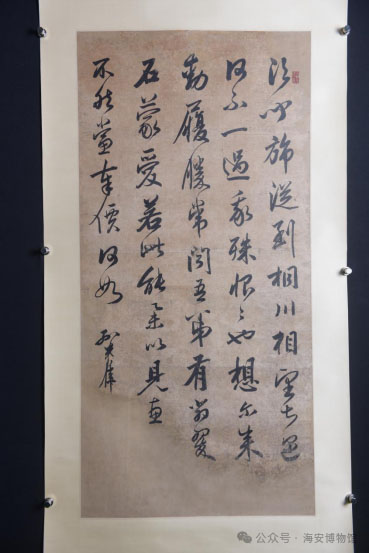Collection
CONTACT US
Tel:
Fax:
Website:www.jshamuseum.com
Add:58-8 Ninghai North Road, Hai'an City, Nantong City

Fax:

Website:www.jshamuseum.com
Add:58-8 Ninghai North Road, Hai'an City, Nantong City
| Sun Xingwei walks on the grass, needs to hear the sound of the tent, and follows the axis |
| Hits:875 Date:2025-09-28 |
[Historical Era]: Qing Dynasty 【 Size 】: 105cm vertically, 53.5cm horizontally 【 Commentary 】: It is necessary to hear about the customs. From Tongchuan to Tongchuan, looking far away, when He Er passes by me, he hates me so much! Thinking of moving and achieving success. I heard that my younger brother has a jade stone. If I love it like this, can I offer it as a token of gratitude? It cannot be returned at a price. Sun Xingwei Seal: Enduring hardships brings joy (Bai Wen) This work is one of the ten volumes of cursive script written by Sun Xingwei and Zhao Mengfu. Sun Xingwei's life is unknown. Zhao Mengfu, a member of the Southern Song royal family, was a calligrapher and painter during the late Song and early Yuan dynasties. His book learning philosophy revolves around the concept of 'ancient meaning'. Zhao Mengfu started with a thousand character script, passed through Zhao Gou, then went on to become the two kings of Wei and Jin, and finally settled in Li Beihai during the Tang Dynasty. He extensively studied various schools of thought and drew on their strengths, eventually forming his own style of calligraphy. Zhao Mengfu emphasized the importance of using the brush in calligraphy, stating that "the brush is the top priority, and the use of labor is also necessary for the formation of characters. The use of the brush has been passed down through time, and the use of the brush has been difficult for thousands of years." The so-called "brush" refers to the brushwork, which was mainly set in the Wei and Jin dynasties. "The formation of characters" mainly refers to the posture and structure of the characters. The relationship between the two is that the brushwork is the body, the formation of characters is the use, and the brushwork is the core, so it is "difficult for thousands of years." The formation of characters can be "passed down through time" as a representation. Zhao Mengfu's calligraphy gives the most intuitive feeling of "roundness and charm", but his charm is not vulgar. Whether in regular script or cursive script, Mengfu embodies the charm of the Wei and Jin dynasties and the atmosphere of the prosperous Tang dynasty. His handwriting is flat, precise, and strict, with a slender structure. His brushwork is exquisite and refined, with smooth and round strokes, and his dots and strokes echo his longing. His breath is connected, with the style of the two kings and the aura of Zhong Yao. He is elegant, graceful, and well-rounded. In addition, one major characteristic that sets Zhao Mengfu's calligraphy apart from other calligraphers is its ability to appeal to both the refined and the popular. From the works of Zhao Mengfu, literati and scholars can glimpse his profound and sophisticated brushwork, which can also be interpreted by ordinary people. Zhao Mengfu's calligraphy style had a profound influence in the Qing Dynasty. In the early Qing Dynasty, many literati learned from Wang Xizhi, especially his "Huangting Jing" and "Leyi Lun". Emperor Shunzhi had a preference for European style calligraphy, while Emperor Kangxi particularly admired the calligraphy of Dong Qichang and Emperor Qianlong favored the calligraphy of Zhao Mengfu. Therefore, during the Kangxi, Yongzheng, and Qianlong periods, a large number of works by Zhao Mengfu were included in the compiled legal documents and ancient books. In the 33rd year of Kangxi's reign, a large number of calligraphy works by Zhao Mengfu and Dong Qichang were included in the "Yuanjian Zhai Fa Tie", which accounted for the majority of the Fa Tie. During the Qianlong period, the "Sanxitang Law Collection" included 33 law collections from Zhao Mengfu. The court's preference for the Book of Zhao naturally influenced people's learning of it. During the Qianlong Dynasty, students who participated in the imperial examination regarded Zhao Mengfu's calligraphy as the standard, and later generations called this calligraphy style learned from Zhao calligraphy the "Guan Ge style". In the Qing Dynasty, the study of calligraphy and the study of steles flourished and declined. In the early and mid Qing Dynasty, the study of calligraphy occupied the mainstream position in the literary world. During the Qing Dynasty, calligraphers such as Wang Duo, Liu Yong, Wang Wenzhi, and Weng Fanggang, who studied calligraphy, often took Zhao Mengfu and Dong Qichang as the correct path, and some even took the Song Dynasty's four schools as bad habits, chasing after the two kings and striving for the Wei Jin style. This phenomenon had an impact on many calligraphers in the Qing Dynasty who studied calligraphy, and Sun Xingwei was one of them. The letter from Sun Xingwei to Zhao Mengfu displayed here contains correspondence about household matters. Therefore, Zhao Mengfu wrote it casually, naturally revealing the author's temperament and interests. Sun Xingwei's works have a touch of freedom and casualness compared to Zhao Mengfu's calligraphy style. The characters are independent and occasionally connected, with ups and downs throughout the text, and even and beautiful reflections. The overall style lacks Zhao Mengfu's round and orderly style, and the structure is more sparse and straightforward. |
| 【Refresh】【Print】 |
| Last:Pink Samsung Wine Cup Next:Withdrawal of Extraterritorial Jurisdiction Policy Examination Paper |




